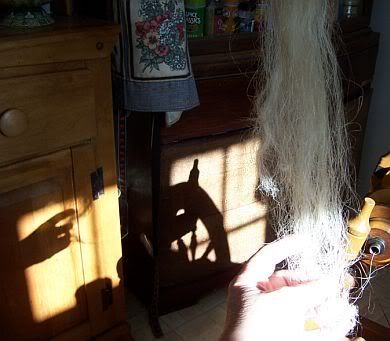
My spinning wheel saw its shadow..six more weeks of winter.....
Spinning flax..... I find that it is easy to understand all the mystery and magic and folklore that surrounds this fiber.
With my wheel parked in the last of the January sunshine, my hands practice the draft, and pulling off the strands from the distaff. At one moment, my hands work quickly, they are efficient, confident and skillful...their timing is perfect as they dip casually into the water pot to smooth and return to the distaff to select the next strands of flax.
It is a curious thing, how the flax turns to linen at the moment it passes between the index finger and the thumb...
...just as I become relaxed in what I am doing, my hands fumble, too much flax is sucked into the zone, and suddenly I am not the master of this ancient herb. It has me bewildered and humbled once more. It snarls and snags upon itself in an instant.There is no turning back easily, as there is with other fibers. As if encountering a large knot at the base of the neck of one's own hair, it refuses to untangle, it is unforgiving.
When I get it right, I look in amazement at two strands plied together that equal the width of the letter "I" in the word "LIBERTY" on a dime. The strength of this thread will test any vacuum cleaner.
In the last stage of its labors, the spun flax thread must be softened. I boil it on the wood/coal stove...for a few hours in soapy water. Angel hair pasta...
Flax is a fantastic plant. I'm enjoying learning all I can about it. The flax featured in these photographs is not my own homegrown...I need to practice a little longer before I use what has taken me a summer to grow and a fall to process..
This spun linen will someday return to the earth from which it came...but that too is one of its qualities that enchants me.
a poem by Richard Frame
"A Paper Mill near German-Town doth stand,
So that the Flax, which first springs from the Land,
First Flax, then Yarn, and then they must begin,
To weave the same, which they took pains to spin.
Also, when on our backs it is well worn,
Some of the same remains Ragged and Torn;
Then of those Rags our Paper it is made,
Which in process of time doth waste and fade;
So what comes from the Earth, appeareth plain,
The same in Time returns to Earth again."
Printed by William Bradford in 1692 in his "A Short Description of Pennsylvania"

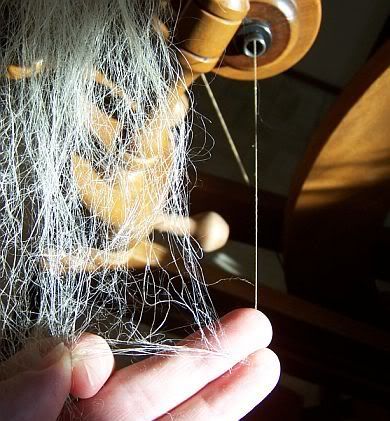
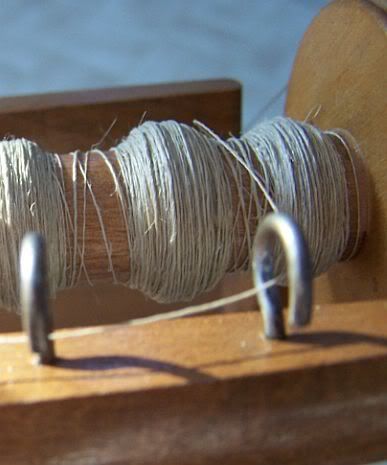

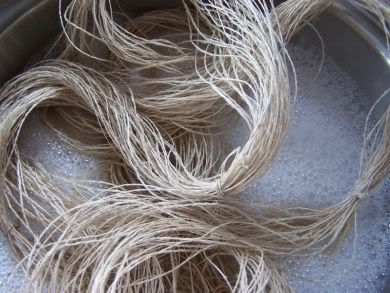
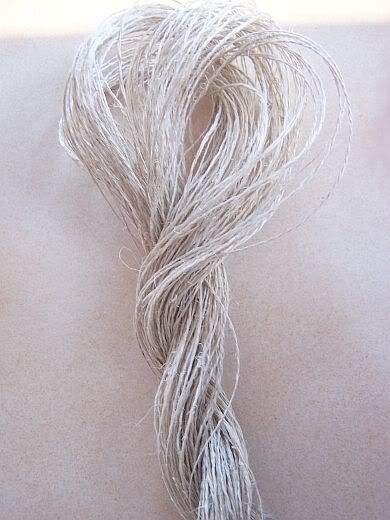


12 comments:
Wow. Your flax yarn looks lovely by comparison with the one I saw spun in the flesh (as it were) by someone really struggling with a dry, dressed distaff. Is the fineness of the prep crucial? Hers looked very coarse.
And I love that poem. Very thoughtful.
Beautiful! Good for you..wish I could touch your hank! One thing I was taught when spinning flax---the plying was not necessary. It isn't for strength! Also, once the flax is spun, the energy doesn't spring back (in my experience) the way wool does. So, there isn't a lot of skewing to worry over, especially if weaving or knitting with texture is your goal.
I also haven't cooked my flax the way you're cooking it--but it makes sense to soften the fibers that way. Love your beautiful illustration of this lost art.
Wonderful poem! I admire your tenacity - I enjoyed learning to spin flax and am happy for the experience, but am more of an instant gratification person at the moment. Maybe if I were a weaver...
Your spinning is exquisite! The color or your flax is a suprise to me, has it been bleached? I have a couple stricks of flax that are unbleached flax that look like a Scandinavian's pony tail.....almost a golden color. It loses its golden quality when spun.
What is the intended end product?
Sarah- I think there are many things that contribute to a fine thread...the quality of the flax itself is, IMHO, the most important.
If the distaff isn't dressed properly, it can make the process of spinning it more difficult.
Joanne- Thanks for sharing your experience with spinning flax. It is always so interesting for me to hear of the different techniques that spinners use to achieve their results.
elizabeth- flax is more of a delayed gratification for sure.
I plan to grow enough to keep me spinning it well into my old age...but then I'm more of a process person anyway ;-)
Valerie- Thank you for your evaluation! The flax I am currently
spinning was purchased years ago at the Mannings Handweaving School. I was told it was imported from Belgium, it is not marked as being bleached. The flax that I grew this past summer is different in color depending on which retting process I used. The flax that was ret in water is much more of a golden color...the dew ret is silver grey.
The intended end project will be woven, alongside of my own flax, on the double whole tape loom. I plan to gift my mother with the tape when I am finished. Her grandmother grew and spun flax in the Carpathian Mountains...a long time ago.
Great post and spun flax. I always learn so much here! Thank you.
This looks like the (waxed)linen that I use to bind the little books I make.
Great job Cyndy. I am amazed at what all you can spin.
What lovely yarn. It's interesting, because the Online Guild is doing a flax spinning workshop this month. I'm only reading about it, with an eye to try my hand at flax some day.
Thanks for sharing your flax spinning , something I have yet to try and I love the poem.
"I plan to gift my mother with the tape when I am finished. Her grandmother grew and spun flax in the Carpathian Mountains...a long time ago."
amazingly perfect.
Thank you Cyndy, for such an interesting and beautiful post. Loved it!
Post a Comment